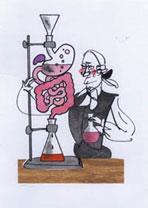Name the French-born chemist who founded pneumatic chemistry, introduced the limewater test for carbon dioxide, discovered an element and pioneered the study of thermodynamics.

Name the French-born chemist who founded pneumatic chemistry, introduced the limewater test for carbon dioxide, discovered an element and pioneered the study of thermodynamics. Antoine Lavoisier? Sorry, but you lose five points; the answer is Joseph Black. Black is always considered to be Scottish, but he was born a French citizen in Bordeaux, the son of a French wine shipper and his Scottish wife. He laid the ground for the chemical investigation of gases (without even isolating the gas), discovered the phenomenon of latent heat and distinguished magnesium from calcium (and yet many books, confusing isolation with discovery, absurdly give the credit to Humphry Davy). 250 years ago, in 1754, Black presented his MD thesis, De humore acido a cibis orto [Concerning the acid liquid derived from foodstuffs], to the Faculty of Medicine at Edinburgh University. The stated aim of his thesis was the use of magnesia as a cure for indigestion, a role which it still fulfils today. However, Black went beyond medicine to use his research to show that magnesia was not the same as lime and that the difference between strong and mild alkalis was the combination of the strong alkali with a gas he called ’fixed air’, which we now call carbon dioxide. He published his chemical findings in their own right a year later, thereby opening the field of pneumatic (or gas) chemistry which was brilliantly developed by Henry Cavendish, Joseph Priestley and Black’s fellow Frenchman, Antoine Lavoiser.
When he returned to Edinburgh in 1766, having taught at Glasgow University for 11 years, Black lived in a house on the east side of College Wynd, overlooking the ornate entrance to the Tounis College (the town’s college is now better known as Edinburgh University). The College Wynd is a narrow passage from the Cowgate to the present-day Old Quad, but no longer accessible by the public. In 1774, Black moved to Argyle Square, but he sold this house to Adam Ferguson, the historian, in about 1781 and moved to Nicolson Street. Argyle Square was eventually demolished to make way for the Royal Scottish Museum. It is stated that Black’s final house in Nicolson Street was located at number 58, which was converted into an asylum for the blind after his death and was demolished in the mid-19th century. Nicolson Street runs south towards Dalkeith and was developed in the late 18th century; the northern half of the street is close to the older parts of the university. Joseph Black’s will states that his house has ’a large balustrade in the front’ and ’three floors and garrets’.
In the 1837-8 Paterson edition of John Kay’s Edinburgh Portraits, it is noted that Black’s house had been taken over by the Asylum for the Female Blind. There were two blind asylums in Nicolson Street, the Asylum for the Industrious Blind, founded in 1806, and the Asylum for the Female Blind in 1822. The Asylum for the Industrious Blind was located at 58 Nicolson Street, the number sometimes given for Black’s house, but demolished in the 1850s. The female asylum was at 38 Nicolson Street in the mid-19th century. A print of the Asylum for the Female Blind in 1866, reproduced in a recent history of the Royal Blind School in Edinburgh (the successor to these blind asylums), matches the description of Black’s house given in his will.
Recent investigations of the area, based on the relationship of Black’s house to nearby Hill Place, have suggested that it is now 46 Nicolson Street (the numbering in that part of the street is rather erratic). It is an elegant three-storey Georgian building (now converted into flats, a bingo hall and an amusement arcade) which is identical to the female blind asylum in 1866, except for some remodelling of the third floor windows and the removal of the balustrade on the first floor. This suggests that Black’s house still survives. Centrally situated in Edinburgh and near the Science Studies Unit of Edinburgh University, could it become a focus for chemistry and its history?












No comments yet